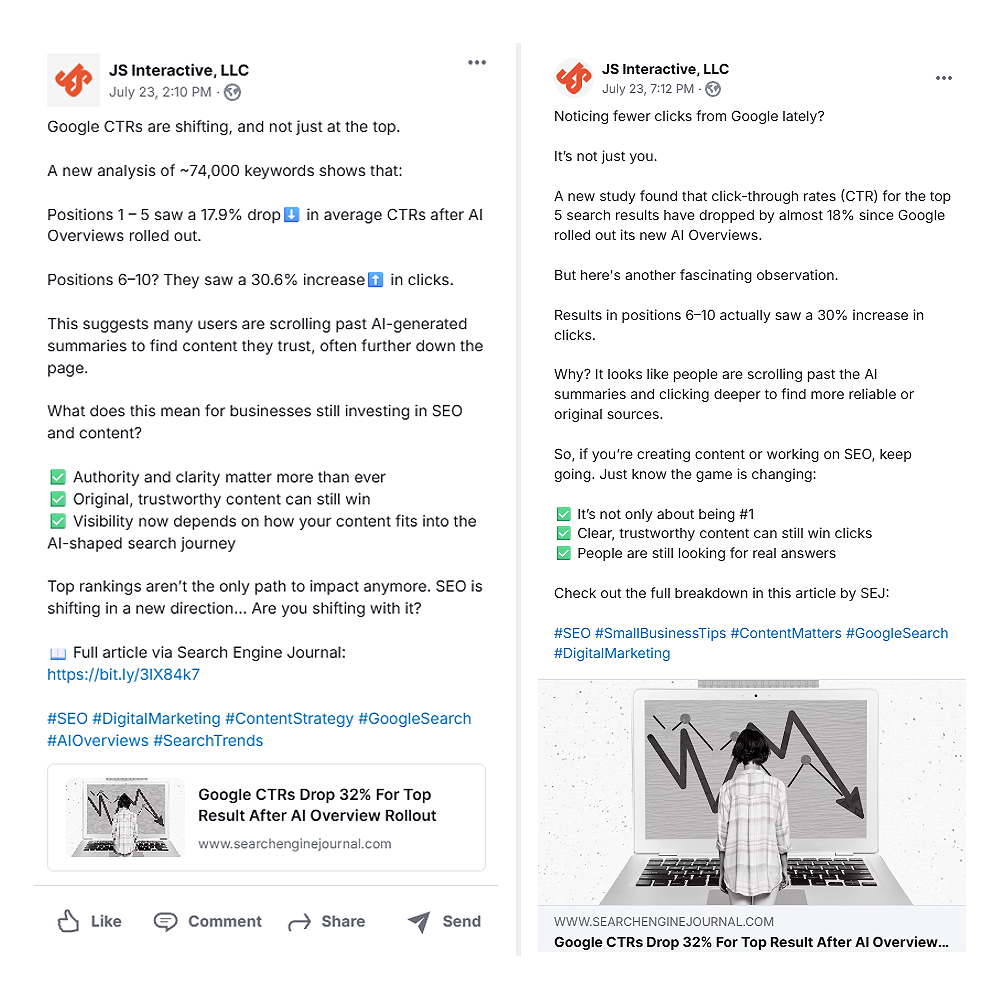5 Smarter Ways to Use Social Media Reposting in 2025

Reposting used to be the fastest way to grow on social. Not anymore.
For years, reposting and resharing were the shortcuts to visibility. Meme accounts and aggregator pages could grab a viral tweet, drop it on Instagram, and rack up likes without creating anything original.
That approach worked.
Until it didn’t.
Now, platforms like Meta and YouTube are rewriting the rules. Recycled content is getting flagged. Monetization is being pulled. Algorithms are favoring creators who bring something new to the table.
This isn’t just about platform policy changes. It reflects a bigger shift in how content works in the AI age.
With more noise flooding social feeds than ever before, originality is becoming the filter. Copy-paste won’t cut it. Repetition gets ignored.
The creators who evolve are the ones who grow.
Reposting Took Over Because It Was Easy. Too Easy.
Reposting didn’t rise on creativity. It grew out of convenience.
For years, brands, meme pages, and aggregator accounts built audiences by recycling content that already performed well. They grabbed screenshots, shared viral quotes, or reposted videos with little context, and it worked.
The algorithm rewarded speed and volume. In many cases, low-effort reposts outperformed the original. Nobody cared who created the content. They cared who shared it first and loudest.
That strategy worked when posting anything was enough to stay visible. Today, the bar is higher, and small teams must work smarter to keep pace.
Repetition gets ignored.
And recycled posts don’t stand a chance.
Platforms Have Had Enough And They’re Making It Obvious
Social platforms aren’t nudging users toward original content. They’re forcing the shift.
Meta now withholds payouts from Facebook pages that post unoriginal or lightly modified content. YouTube applies similar penalties, targeting reused video clips and AI-generated compilations that lack meaningful input from the creator.
Platform tools have also evolved. Detection systems now flag recycled content more quickly and with greater accuracy. What once flew under the radar now gets throttled before it reaches an audience.
These aren’t surface-level changes. They reflect how seriously platforms treat originality in a feed flooded with auto-generated noise. If your content doesn’t add something new, it doesn’t move.
Who’s Getting Hit Hardest by the Reposting Crackdown
Some accounts are feeling the shift more than others. The ones that relied on volume over value are taking the biggest hit:
- Aggregator pages that repost without context or transformation
- Meme accounts that depend on screenshots instead of original content
- Small creators who used reposting to grow but never built a clear voice of their own
- Brands that post often but say nothing meaningful
These pages thrived when platforms prioritized activity over quality. But in a feed full of AI-generated noise, that model breaks down fast.
Platforms now favor creators and businesses that show effort, originality, and a point of view. Those who continue to repost the old way are already losing traction, and in some cases, visibility altogether.
Not All Reposts Are Dead, But the Rules Have Changed
Reposting still exists on social platforms. But the way it’s treated and what’s allowed to succeed have shifted significantly.
The updated rules are very straightforward:
- Platforms now downrank low-effort reposts. Facebook and YouTube utilize detection systems to flag content that has been copied with minimal or no changes. That includes unedited memes, screenshots, and clipped video montages.
- AI-generated content faces tighter enforcement. YouTube penalizes accounts that mass-upload AI-curated videos without meaningful input. These uploads no longer qualify for monetization.
- Monetized posts must show original value. Facebook’s Partner Monetization Policies now require creators to enhance any content they didn’t create themselves meaningfully.
- Lack of attribution raises red flags. Tagging the original creator or linking the source is no longer optional. It signals trust and transparency, both to the platform and to your audience.
These are not minor algorithm shifts. They reflect a deeper push to promote originality and filter out noise.
Reposting can still work, especially for lean teams. However, it needs to reflect effort, rather than relying on other creators.
If You Want to Grow, Make Sure You’re Doing These 5 Things
If you want to grow, your content needs to do more than fill space. Social platforms now reward originality, clarity, and consistency. What used to work — fast reposts and borrowed formats — no longer gets results.
The good news is you don’t need to start from scratch. You just need to be more deliberate, not more active. A few well-crafted posts go further than a dozen half-baked ones.
Here’s where to focus your efforts:
1. Build Original Formats That Reflect Your Voice
You don’t need a brand-new idea every time you post. But you do need content that reflects your perspective and tone. That’s what makes it original.
Originality doesn’t just live in what you say. It shows up in how you say it. Your brand voice is what makes a post feel like it came from you, not from a template or trend.
This is where format becomes your advantage. It gives structure to your voice and makes your content recognizable over time.
- Define two or three themes that you can speak to consistently
- Create simple, repeatable formats that reflect your tone and messaging
- Make your posts feel like they came from your brand, not the algorithm
When your content is consistent in both structure and voice, your audience starts to remember it. That’s how originality turns into recognition.
2. Use Reposts as Raw Material, Not the Final Product
Reposting isn’t off-limits. But it’s no longer a shortcut for staying active online.
If you’re sharing something that already exists, your job is to shape it. Use it as a jumping-off point, not a plug-and-play solution. When done well, reposting adds context and value. When done carelessly, it fades into the feed.
- Start with something timely or familiar, but reshape it in your voice
- Treat reposts like prompts: a place to begin, not where the content ends
- Use them to introduce a takeaway, not just repeat what’s already been said
Reposts can still serve a purpose. Just make sure they support your message, not replace it.
3. Add Context, Personality, and Relevance
Reposting a headline or clip without adding anything to it doesn’t earn attention. In a content-heavy feed, the only way to stand out is by helping your audience understand why something matters.
This is where originality shows up in your thinking. Don’t just share.
Interpret.
Connect the dots.
Effective content addresses real needs, not just trends, which is why people-first marketing continues to win attention.
Add your tone, your angle, your experience. Whether that’s a client insight, a personal story, or a challenge to the status quo, it needs to feel like something only you would post.
And make it relevant. Filter everything you share through your audience’s needs. Ask whether it informs, clarifies, or sparks something worth responding to.
The right context turns a repost into a conversation. That’s what makes it work.
4. Think Remix, Not Repeat
What about reposting your own content? That can still be a smart move, but only if you do it with intention.
Sharing the same video, blog post, or quote across multiple platforms can help extend its reach. But each version should feel like it belongs where it’s posted. A caption that works on LinkedIn won’t land the same way on Instagram or YouTube Shorts.
The content can stay the same. The presentation needs to change.

Adapt the hook, tone, and call to action to make each version feel native to the platform. You don’t need to create new content for every platform. You just need to adjust the delivery so that it feels natural wherever it appears.
This slight shift shows your audience you understand how they engage on each platform. That kind of effort earns attention and builds trust.
5. Give Credit, Even When You Don’t Have To
Nothing erodes trust faster than posting content that clearly isn’t yours and pretending otherwise. Even if the platform doesn’t catch it, your audience probably will.
Giving credit is simple. It shows that you respect the original creator, that you know where something came from, and that you are not just chasing engagement. It also helps protect you from moderation issues or flagging, both of which are becoming more common as platforms enforce stricter rules around attribution.
A quick tag, a mention, or a link to the original post can go a long way. It signals transparency and builds credibility with your audience.
In a crowded feed, showing where your ideas come from is no longer optional. It’s part of what makes your content trustworthy and worth following.
Reposting Isn’t the Shortcut It Used to Be
Growth today requires more than speed and volume. It requires thoughtful execution across every touchpoint, especially SEO and digital marketing for small businesses.
It requires a fundamental point of view, a compelling reason to post, and the effort to tailor content to the specific audience you want to reach.
You don’t need to abandon reposting. You just need to use it differently. The brands and creators who adapt will continue to grow. The ones who don’t will fade into the noise.
If your team is ready to spend less time guessing and more time growing, JS Interactive can help.
Contact us today and let’s create content that’s worth sharing.